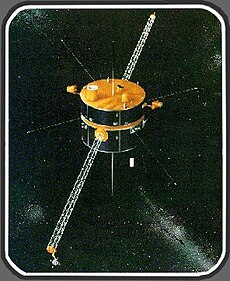WIND (spacecraft)

The first of NASA's Global Geospace Science (GGS) program.
|
|||||||||||||||||||
| Mission type | Heliophysics | ||||||||||||||||||
|---|---|---|---|---|---|---|---|---|---|---|---|---|---|---|---|---|---|---|---|
| Operator | NASA | ||||||||||||||||||
| COSPAR ID | 1994-071A | ||||||||||||||||||
| Website | Official Page | ||||||||||||||||||
| Mission duration | Minimum: 3 year Elapsed: 22 years, 3 months and 26 days |
||||||||||||||||||
| Spacecraft properties | |||||||||||||||||||
| Manufacturer | Martin Marietta | ||||||||||||||||||
| Launch mass | 1,195 kg (2,635 lb) | ||||||||||||||||||
| Dry mass | 895 kg (1,973 lb) | ||||||||||||||||||
| Start of mission | |||||||||||||||||||
| Launch date | 08:31, November 1, 1994 | ||||||||||||||||||
| Rocket | Delta II | ||||||||||||||||||
| Launch site | Cape Canaveral SLC-17 | ||||||||||||||||||
| Orbital parameters | |||||||||||||||||||
| Reference system | Heliocentric | ||||||||||||||||||
| Regime | L1 Lagrangian point | ||||||||||||||||||
| Semi-major axis | ~100 RE | ||||||||||||||||||
| Sun orbiter | |||||||||||||||||||
| Orbital insertion | 2004 | ||||||||||||||||||
|
|||||||||||||||||||
|
International Solar Terrestrial Physics (ISTP) program
|
|||||||||||||||||||
| Instruments | |
|---|---|
| 3DP | A Three-Dimensional Plasma and Energetic Particle Investigation |
| TGRS | Transient Gamma-Ray Spectrometer |
| MFI | Magnetic Field Investigation |
| WAVES | The Radio and Plasma Wave Investigation |
| SWE | Solar Wind Experiment |
| SMS | Solar Wind and Suprathermal Ion Composition Investigation |
| KONUS | Gamma-Ray Burst Experiment |
| EPACT | Energetic Particles: Acceleration, Composition, and Transport Investigation |
The Global Geospace Science (GGS) Wind satellite is a NASA science spacecraft launched at 04:31:00 EST on November 1, 1994, from launch pad 17B at Cape Canaveral Air Force Station (CCAFS) in Merritt Island, Florida aboard a McDonnell Douglas Delta II 7925-10 rocket. Wind was designed and manufactured by Martin Marietta Astro Space Division in East Windsor, New Jersey. The satellite is a spin stabilized cylindrical satellite with a diameter of 2.4 m and a height of 1.8 m.
It was deployed to study radio waves and plasma that occur in the solar wind and in the Earth's magnetosphere. The spacecraft's original mission was to orbit the Sun at the L1 Lagrangian point, but this was delayed to study the magnetosphere and near lunar environment when the SOHO and ACE spacecraft were sent to the same location. Wind has been at L1 continuously since 2004, and is still operating as of 27 February 2017.Wind currently has enough fuel to last over 50 years at L1. Wind continues to produce new and exciting scientific results and as of January 31, 2017 (not including 2017 publications) has accumulated over 4310 refereed scientific publications.
...
Wikipedia
